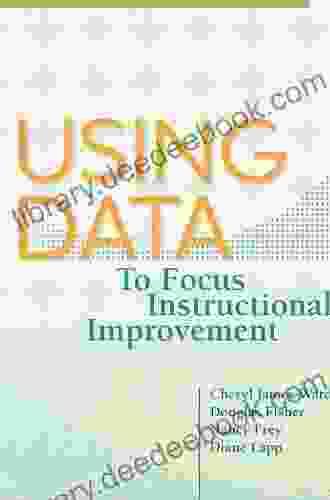Using Data to Focus Instructional Improvement

4.6 out of 5
| Language | : | English |
| File size | : | 976 KB |
| Text-to-Speech | : | Enabled |
| Enhanced typesetting | : | Enabled |
| Word Wise | : | Enabled |
| Print length | : | 145 pages |
| Screen Reader | : | Supported |
In today's data-driven educational landscape, educators are increasingly leveraging data to inform instructional decisions and drive improvement efforts. Data provides valuable insights into student learning, teacher effectiveness, and program implementation, allowing schools and districts to identify strengths, weaknesses, and areas for growth.
This comprehensive guide will explore the effective use of data to focus instructional improvement. We will discuss strategies for collecting, analyzing, and interpreting data, as well as practical examples and best practices for using data to inform decision-making and drive improvement efforts.
Benefits of Using Data for Instructional Improvement
- Identify areas for improvement: Data can help educators pinpoint specific areas where students are struggling or where instruction could be more effective.
- Develop targeted interventions: By analyzing data, educators can develop targeted interventions that are tailored to the specific needs of students.
- Evaluate the impact of interventions: Data can be used to track the progress of students who are receiving interventions and evaluate their effectiveness.
- Inform decision-making: Data provides educators with the information they need to make informed decisions about instruction and program implementation.
- Improve student outcomes: Ultimately, using data for instructional improvement can lead to improved student outcomes.
Collecting Data for Instructional Improvement
The first step in using data for instructional improvement is to collect data. There are a variety of data sources that educators can use, including:
- Student assessments: Student assessments provide data on student learning. This data can be used to identify students who are struggling and to track the progress of students over time.
- Teacher observations: Teacher observations provide data on teacher effectiveness. This data can be used to identify areas where teachers need support and to provide feedback on instruction.
- School data: School data provides information on school-wide factors that can impact student learning. This data can be used to identify trends and patterns and to make decisions about school-wide initiatives.
- External data: External data provides information on factors outside of the school that can impact student learning. This data can be used to compare the school to other schools and to identify areas for improvement.
Analyzing Data for Instructional Improvement
Once data has been collected, it is important to analyze the data to identify trends and patterns. There are a variety of data analysis techniques that educators can use, including:
- Descriptive statistics: Descriptive statistics provide a summary of the data. This information can be used to identify the central tendency and variability of the data.
- Inferential statistics: Inferential statistics allow educators to make inferences about the population from which the data was collected. This information can be used to test hypotheses and to make predictions.
- Data visualization: Data visualization techniques can be used to represent data in a visually appealing way. This information can help educators to identify trends and patterns more easily.
Using Data to Inform Instructional Decisions
Once data has been analyzed, it can be used to inform instructional decisions. Here are some examples of how data can be used to improve instruction:
- Identify students who are struggling: Data can be used to identify students who are struggling in specific areas. This information can be used to provide additional support to these students.
- Develop targeted interventions: Data can be used to develop targeted interventions that are tailored to the specific needs of students. These interventions can be provided in a variety of settings, such as small group instruction, one-on-one tutoring, or online learning.
- Evaluate the impact of interventions: Data can be used to track the progress of students who are receiving interventions. This information can be used to evaluate the effectiveness of the interventions and to make adjustments as needed.
- Make decisions about instruction: Data can be used to make decisions about instruction. For example, data can be used to determine the pacing of instruction, the grouping of students, and the use of specific instructional strategies.
Best Practices for Using Data for Instructional Improvement
Here are some best practices for using data for instructional improvement:
- Use a variety of data sources: Using a variety of data sources can provide a more comprehensive view of student learning and teacher effectiveness.
- Analyze data regularly: Data should be analyzed regularly to identify trends and patterns. This information can be used to make timely adjustments to instruction.
- Share data with stakeholders: Data should be shared with stakeholders, such as teachers, parents, and administrators. This information can help to build consensus and support for instructional improvement efforts.
- Use data to inform decision-making: Data should be used to inform instructional decisions. This information can help to ensure that decisions are based on evidence rather than on intuition or tradition.
- Evaluate the impact of data-driven decisions: The impact of data-driven decisions should be evaluated regularly. This information can be used to make adjustments to the data-driven decision-making process as needed.
Data is a powerful tool that can be used to improve instruction. By collecting, analyzing, and using data, educators can identify areas for improvement, develop targeted interventions, and evaluate the impact of their efforts. Following the best practices outlined in this guide, educators can use data to make informed decisions that lead to improved student outcomes.
4.6 out of 5
| Language | : | English |
| File size | : | 976 KB |
| Text-to-Speech | : | Enabled |
| Enhanced typesetting | : | Enabled |
| Word Wise | : | Enabled |
| Print length | : | 145 pages |
| Screen Reader | : | Supported |
Do you want to contribute by writing guest posts on this blog?
Please contact us and send us a resume of previous articles that you have written.
 Page
Page Chapter
Chapter Text
Text Story
Story Reader
Reader Magazine
Magazine Newspaper
Newspaper Sentence
Sentence Glossary
Glossary Bibliography
Bibliography Foreword
Foreword Preface
Preface Synopsis
Synopsis Annotation
Annotation Footnote
Footnote Manuscript
Manuscript Codex
Codex Classics
Classics Narrative
Narrative Autobiography
Autobiography Dictionary
Dictionary Thesaurus
Thesaurus Narrator
Narrator Catalog
Catalog Borrowing
Borrowing Stacks
Stacks Periodicals
Periodicals Study
Study Research
Research Scholarly
Scholarly Academic
Academic Journals
Journals Reading Room
Reading Room Rare Books
Rare Books Special Collections
Special Collections Interlibrary
Interlibrary Literacy
Literacy Thesis
Thesis Dissertation
Dissertation Storytelling
Storytelling Knuts Skujenieks
Knuts Skujenieks Joel Spring
Joel Spring Vince Khan
Vince Khan Greater Than A Tourist
Greater Than A Tourist Mika Lane
Mika Lane Cj Lyons
Cj Lyons Michael Kranish
Michael Kranish Casey Watson
Casey Watson Willow Fox
Willow Fox J Gavin Paul
J Gavin Paul Eleni Kounalakis
Eleni Kounalakis Bill Finley
Bill Finley Lisa Moser
Lisa Moser Suzanne Falter
Suzanne Falter Gary A Yukl
Gary A Yukl Patsy Rodenburg
Patsy Rodenburg Nick Vandome
Nick Vandome Sandra Ingerman
Sandra Ingerman William Hickling Prescott
William Hickling Prescott Eric Gurney
Eric Gurney
Light bulbAdvertise smarter! Our strategic ad space ensures maximum exposure. Reserve your spot today!

 Leo TolstoyThe Complete Works of Julius Caesar: A Comprehensive Examination of the Roman...
Leo TolstoyThe Complete Works of Julius Caesar: A Comprehensive Examination of the Roman...
 Henry Wadsworth LongfellowUnveiling the Hidden Complexities: A Comprehensive Analysis of 'The Trouble...
Henry Wadsworth LongfellowUnveiling the Hidden Complexities: A Comprehensive Analysis of 'The Trouble... Edwin BlairFollow ·18.2k
Edwin BlairFollow ·18.2k Isaac MitchellFollow ·8.9k
Isaac MitchellFollow ·8.9k Aron CoxFollow ·3.8k
Aron CoxFollow ·3.8k Hugh ReedFollow ·18.1k
Hugh ReedFollow ·18.1k Giovanni MitchellFollow ·2.9k
Giovanni MitchellFollow ·2.9k Dan HendersonFollow ·5.9k
Dan HendersonFollow ·5.9k Gilbert CoxFollow ·14.6k
Gilbert CoxFollow ·14.6k Kazuo IshiguroFollow ·10.9k
Kazuo IshiguroFollow ·10.9k

 Ralph Ellison
Ralph EllisonHealth Care Global Viewpoints: Samantha Whiskey
Samantha Whiskey is a global health...

 Gabriel Garcia Marquez
Gabriel Garcia MarquezTeacher Educators' Reflections on Culturally Relevant...
In today's...

 Levi Powell
Levi PowellSustainable Project Management: The GPM Reference Guide...
In today's rapidly changing world,...

 Isaac Bell
Isaac BellThe Captivating World of "Dreaming Awake Falling Under"
A Journey Through...

 Clarence Brooks
Clarence BrooksGovernance Regulations Valuations Mergers And...
In today's complex and ever-changing...
4.6 out of 5
| Language | : | English |
| File size | : | 976 KB |
| Text-to-Speech | : | Enabled |
| Enhanced typesetting | : | Enabled |
| Word Wise | : | Enabled |
| Print length | : | 145 pages |
| Screen Reader | : | Supported |










